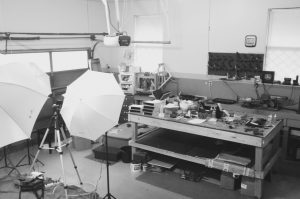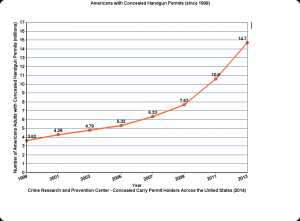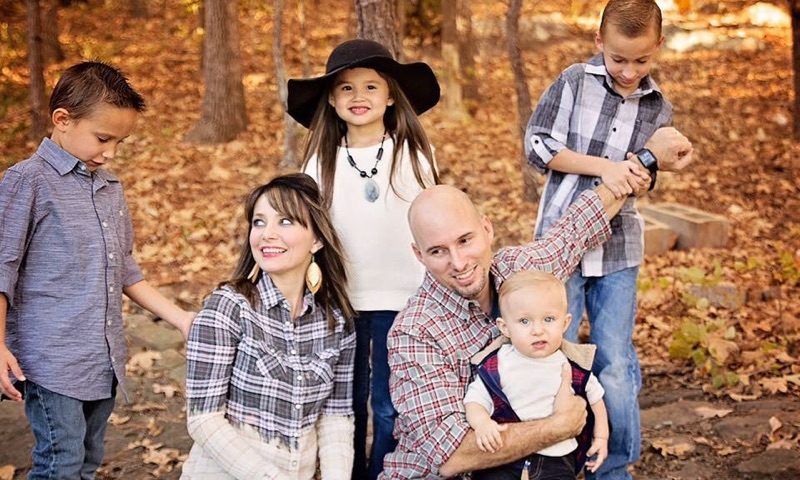April 7, 2017
“We will be the largest manufacturer of gun holsters in America within the next five years.”

A mock-up of the new Clinger Holsters facility in Van Buren, Ark. The company was launched from Chris and Sherry’s garage in 2013.
Sherry Tedder’s words are simple and to the point when she explains the vision for Clinger Holsters of Van Buren, Arkansas.
Five years ago, Sherry and her husband Chris moved into the Van Buren home where Chris would first build and sell the No Print Wonder Holster from a garage. Five years from today, the two hope to rival big American manufacturers of concealed carry holsters like Desantis and Galco.
Their vision – ambitious though it may seem – has been shaped by many late nights and early mornings; by hours spent tinkering to develop a design for the holster that provides absolute concealment. Their vision is the same type of vision common among many startups – companies that have experienced rapid growth and tasted the success that comes from having a good idea. Their ambition is the type of ambition that isn’t afraid to make a splash – to step on the toes of the big guys and sell to a market notorious for dissatisfaction. Chris himself had never been satisfied with holsters he could buy.
While serving as parents to three young children (they now have four), Sherry devoted her entire nursing salary to fund the Clinger Holster startup. For months, Chris would work full time as a software engineer by day for Goodyear. He would come home and build his holsters, working well into the early morning. In those days, Chris would only sleep for three hours a night.
When Chris was 20 years old, he read business books to learn all he could about starting his own company. He graduated college seven years ago. Owning his own business had always been a dream of his and he had attempted other businesses before Clinger Holsters.
“In that same garage, I tried a couple of other little business ideas that never gained traction,” he recalled. “Landscaping companies and things here and there.” But like he said, these ideas never gained traction and Chris did not want to waste himself on an idea that he never had the time and resources for.
“You never really have the time and resources to devote to it – though I guess you never really do until you just do it,” he says. After these other ideas lost steam, Chris took a step back and told himself “I’m going to make a holster.”
A software engineer that attempts landscaping who then decides he wants to make gun holsters. To anyone this would naturally seem like an unusual progression. But Chris had other motivations on his heart which had long been at work. His decision to pursue holsters was fueled by his goal to become a successful businessman; by the fact that he was skilled at tinkering with his hands; and by his wish to find the perfect concealed-carry holster. As a citizen who exercises his right to concealed-carry, Chris has never been satisfied with holsters he could buy. Some have come close, he says but never has he found the perfect one.
“He wanted something that concealed-carried better than anything on the market,” Sherry recalled. “I remember him telling me ‘I can’t find it so I’m gonna make it.”
“I wanted to see how that worked out,” Chris said nodding his head as his wife recalled the memory. “I wanted to see if I could go in there and actually do it. I remember first showing the holster to my neighbor and he said ‘Wow, you made that?’ I started thinking I can do this. Then I thought maybe I will do this.”
THE NO PRINT WONDER
What Chris had achieved was a holster design that has since splashed into the concealed-carry market and made history. Better than any other holster on the market, the “No Print Wonder Holster” promises to conceal a handgun by eliminating the “print” which can occur as the outline of a handgun is visibly pressed against the clothing of the carrier. Printing is often a concern for carriers who do not wish to get into legal trouble if someone is frightened or disturbed by the sight of their weapon. Many states legally differentiate “brandishing” a weapon from what is considered printing. However in many states, the legal wording is vague and depends on the reaction of others and is a grey area overall. The No Print Wonder Holster offers peace of mind to everyone.
Through a clever adjustable retention system that utilizes screws and what Chris calls the Stiff Cling Tab System, the holster can press a pistol’s grip – the hardest part to conceal – close to the body. Snugly nestled against the back of an individual, the holster can successfully conceal even large handguns.
“Absolute concealment. That’s always been the goal,” Chris says.
Those two words can be seen printed in bold white stencil on the company’s red and black branding. A crab with open claws ready to snap and cling snugly to anything that comes within reach serves as a unique and memorable logo. The holster itself even evokes the image of a crab with a stiff shell and cling tabs extended both left and right like claws.
“With this idea, I had immediate traction,” Chris said.
They started selling from magazines while they were still in their garage. If you had walked into Books-a-Million or Barnes and Noble four years ago, and picked up a gun magazine you might have found their ads. But magazine ads are thousands of dollars and the two had to be very strategic in the early stages of the business.
“You find the ones that work and stick there and drop the ones that don’t,” Sherry said. Social media and their website have been part of the strategy from the beginning.
Eventually Chris could put a stop to those 21 hour days and devote himself to the company fulltime. Sherry stopped nursing and became the COO of Clinger Holsters. One might say that the company’s official takeoff was in 2013 – when they began selling from their garage. Chris feels that only once they moved into their current shop and hired employees, his dream finally took off. However, Chris can be proud of those garage days. It places him on common ground with giants like Steve Jobs. Apple, like Clinger Holsters, made its launch from a garage too.
THE PERSONAL CONNECTION

The Tedder garage where Chris would work for hours into the early morning building his holsters. They ended production of the holsters in the garage in 2014 and moved into a new facility in January 2015.
Yet, launching the business is only the beginning. When Chris and Sherry’s vision is taken into consideration, Clinger Holsters still has many more hills to climb. They started with social media and magazine ads. They have achieved enough success to use their website as a primary platform for sales. They can continue to sell ads, use social media and target their markets but like thousands of different winemakers at a wine convention who must fight to distinguish their product, Chris and Sherry must battle to distinguish their holsters where they can easily get lost among hundreds of different voices all promising to offer the best.
“You have to have a better product. It helps to be reasonably priced but if you can brand it and give people a strong personal connection – that’s what is key.” This is Chris’ formula for success but what does he mean by a personal connection?
“One guy is a Ford guy and one guy is a Chevy guy,” he offers as an illustration. “And they will defend which is better over a fight in a bar,” he says, almost chanting the words to emphasize his point. “That’s the personal connection! To everyone else it’s just a brand but to those guys – it’s personal.”
Personal and worth fighting for. Chris’ example will resonate with Arkansans who, reflecting on their childhood, might easily identify their fathers as Chris’ “Ford guy” or “Chevy guy.” It will resonate with Americans who search for meaning and significance in fulfilling their deepest personal values – values like “God, Family and Country” – through the tools they use.
But far from wanting to inspire violence over their holster, Chris and Sherry hope instead to inspire loyalty to the No Print Wonder Holster that can only come by proving itself as a strong and worthy companion in what their customers consider matters of life and death.
“People establish their identities through brands – it’s what our culture does,” Chris observes. “You have to have a strong brand for your product’s potential to rub off.”
Many of Chris’s customers spend a lot of time on internet forums where they offer shared experiences and debate the best types of equipment. When people attach their identity to a certain brand or product, then have that product challenged, things can get heated – they see it as a challenge to their identity.
“If you go into a forum where people are debating that this gun is better than that gun – it gets rude,” Chris said. “One guy might say to another ‘Your Glock is the crappiest piece of crap ever – I can’t believe you would support that!’ but this Glock guy is on there saying ‘No, it’s better and this is why.’ So, this Glock guy has found a product that he likes and he’s going to tell his friends that he likes it.”
And those friends are going to listen to him. Then they will share it and continue to share it. Eventually they will meet a skeptic who challenges their attachment to the product but Chris says that he if he can establish that personal connection, then his buyers will convince others that his holsters are worth buying.
It boils down to an endorsement from people these potential buyers trust. If the people they trust also trust Clinger Holsters through their personal connection with the product, then Chris and Sherry will continue to see growth and success.
LOOKING TO THE FUTURE

The number of Americans with concealed handgun permits has grown by more than 10 million since 1999. The Clinger Holster Market can expect major growth.
Today, Clinger Holsters offers three different models of concealed carry systems. This number will jump up to four within the next month. Their systems can support up to 500 models of guns and this new product line is a more universal model that can be easily mass produced and globally sold.
So, what happens when they have reached their goal? What will they do when they can proudly claim to be the biggest manufacturers of gun holsters in America?
“We just keep expanding globally,” Chris says. “Then we move to other products. We don’t have to stop at holsters. We can go to many other accessories and we don’t even have to stop at gun accessories.”
Clinger Holsters are being requested by police departments, private investigators and law enforcement. They are proud to offer a military, police and veterans discount. They currently ship to Puerto Rico through EBay and have reached out to the World Trade Center Arkansas – who offer trade services and resources to Arkansas companies just like theirs – in hopes of bringing their holsters to international markets such as Brazil and Venezuela and expanding their Puerto Rico sales. Chris says that Asia may even be an option someday.
Clinger Holsters has grown substantially. They boast more than 350,000 subscribers on Facebook, where even influential profiles like the the official U.S. Navy account has liked the company. They are currently in the process of relocating to a site that will better suit their needs and the demand (see the mock-up photo above). They are members of the National Rifle Association and the National Shooting Sports Foundation. They proudly boast that the products are made in America. It was Chris and Sherry’s determination that fueled them to achieve this level of success when three hours of sleep could not.
Chris and Sherry’s journey – Chris working 21 hour days for months; the sacrificing of Sherry’s income to fund her husband’s dream; the obstacles and hardships and the sweet rewards of their faith – are par for the course of successfully launching your own business. Facing them has earned Chris and Sherry an honored place among the great American entrepreneurs who have sacrificed so much time, energy and effort developing a great idea into a successful enterprise. Their story, like the story of so many other enterprising Americans, can resonate with us all.
Written by Sam Cushman of the World Trade Center Arkansas.





